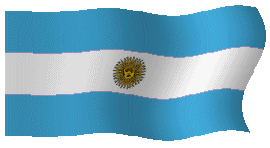
THE HOME WINE COURSE ©

Introduction:
With Argentina we have arrived in the Americas, part of the New World of European colonization during the Age of Discovery. Argentina's wine production is the fourth largest in the world with the yearly harvest surpassing all the other Southern Hemisphere wine countries' combined output. Early 20th Century European immigration patterns (which included many Spanish, Italians, and Germans) virtually assured that experienced vignerons with the requisite noble vinifera rootstock would also come to quench the thirst of these wine-oriented people. Early on Italian varietals and Spanish winemaking traditions held sway (which meant extensive use of oak-aging) and this rather tired and woody style is still preferred in Argentina's domestic markets. Lately however, Argentinian export wines (vinos finos) have wowed the rest of the wine-world with their more balanced French-styled elegance and ridiculously low Third World pricing. These wines are vying with those of neighboring Chile to become the value alternative for many wine enthusiasts who can't currently afford their favorite French or Californian labels. But modern Argentinian wines shouldn't be considered as mere stand-ins as they are quite unique in their own right as we shall soon learn!
Levels of Quality
Argentina's wine industry suffers not from a lack of government controls (imposed by the INV - Instituto Nacional Vitivinicultura) on winemaking practises and vineyard management but more from not having an organized regional and subregional appellation structure. Consequently it's hard to tell which areas are producing cheap jug wines from those that are excelling with more premium quality. This forces the export market consumer to focus on the individual producers of Argentinian wine. The INV oversees wine production for the export wine market vigorously so at least we can be sure of a certain basic consistency of quality with these wines. But we must rely on our good judgement (and the advice of a knowledgeable wine guide) to determine which Argentinian export wines are the best in each category. Terms seen on Argentinian wine labels like Reserve Particuleur or Colección Privada, while not official designations, usually indicate a winery's higher quality product. Estate-bottled wines are also to be sought out for their generally higher degree of refinement.
Grape Types
In colonial times two grape varietals dominated the Argentinian vineyards just east of the Andes Mountains. These were the Criolla and the Muscat cultivars that were used principally to make sacramental wines. These two are still used currently but they have been joined by a host of other European vinifera from France, Italy, and Spain. Immigrant vignerons planted the vines they were familar with in the old country; grape types which represent all the finest wines the world has to offer today. From France came the red varietals: Cabernet Sauvignon, Cabernet Franc, Malbec, Merlot, Pinot Noir, and Syrah. From Italy came the Nebbiolo, Barbera, and Sangiovese. And, from Spain, came Rioja's favorite: Tempranillo. Bonarda from Portugal is becoming more popular as well. These reds were planted somewhat indiscriminately and were blended in like manner up until recently (at least for the export market). The most notable of this group is strangely enough the lowly Malbec. Used as a minor blending varietal in Bordeaux and as a primary in Cahors, over time it has developed in the dry and hot climate of Argentina' Mendoza region into a truly first-class red wine resource. Almost always mellowed by wood age with complex tobacco and leather scents, Argentinian Malbec is a special wine experience although the cheaper versions may show a distinct pruney note. Next in line, Cabernet Sauvignon and Merlot wines follow closely in much the same style yet with less of Mendoza Malbec's richness. For interesting blends the Cabernet/Malbec combination is usually the most successful. White wines are garnering increasing recognition by the red wine-oriented Argentines. Two grape types excel here. Understandably one of these is the ubiquitous Chardonnay of Mendoza which has much in common with French Chablis wines; steely, understated, balanced. The most surprising white varietal is the Torrontés, originally from Portugal; intensely aromatic, yet crisply refreshing with high-toned citrus and melon flavor accents. Many other white grapes are utilized in the vast sea of vineyards in Argentina, including the Semillon, Sylvaner, Riesling, Palomino, andTrebbiano varietals.
Regions of Production
Vinegrowing for wine production in Argentina is primarily located in the massive, central western province of Mendoza up against the eastern shadow of the Andes Mountains. This temperate, dry zone requires irrigation to flourish and controlled water run-off from the Andes provides the perfect answer. Higher elevation vineyard sites are best of course. Within the amorphous Mendoza region are many as yet underappreciated subdistricts with their own soil profiles and microclimates. In time these areas will become better known for the distinct wines produced there. Winegrapes are also planted in the northwestern provinces of San Juan, La Rioja, Catamarca, and Salta with certain Andean foothill subdistricts of the latter two showing great promise for fine wine production. Over 45,000 acres of vineyards of premium red and white varietals have been established in the cooler central province of Rio Negro located in the northern part of Argentina's stormy, cold Patagonia region. The Rio Negro district (quite popular with Argentinian consumers) apparently has the greatest potential to produce exceptional European-style wines.
Summary
Argentinian wines are in prime position to burst upon the world wine stage. They are still quite inexpensive and are becoming more user-friendly as vintners mature the wine for shorter periods in barrel thus making fresher, more fruit-intense wines. Still these wines are in general more restrained or European in style making them more perfect for nearly all wine and food combinations than as simple cocktail wines. The best Argentinian Malbec-based reds compare with expensive Bordeaux and this fact alone makes experimenting with them worthwhile. Look for rising levels of quality in the complex, Burgundian-style Chardonnay and Pinot Noir category as well.
Tasting Notes:
Top
Argentina Map
Argentina Review